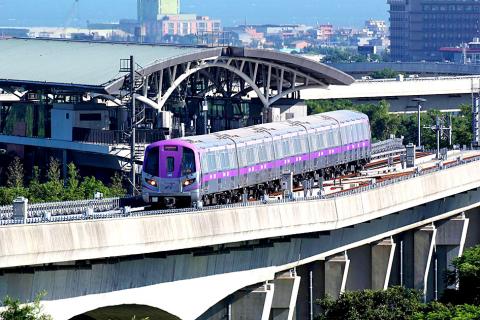The Railway Bureau yesterday said that it is seeking to settle a dispute with Tokyo-based Marubeni Corp through third-party arbitration over the firm’s alleged failure to fulfill the terms of a contract for the Taiwan Taoyuan International Airport Access MRT System.
The Airport MRT Line was launched on March 2, 2017, and approximately 80,000 passengers travel in the system daily.
However, the bureau said that it has yet to conduct a final inspection and acceptance of the project, as its signaling system has yet to meet the standards in the contract.

Photo courtesy of Taoyuan Metro Corp
The Government Procurement Act (政府採購法) stipulates that a contractor should be required, by a notice, to make improvements for any item found not in conformity with the requirements specified in a contract.
Although passengers are able to travel from Taipei Railway Station to Taiwan Taoyuan International Airport’s Terminal 1 in 35 minutes, the contract states that the travel time must also include a one-minute stop at the New Taipei Industrial Park Station (A3) station for baggage transport, the bureau said.
Taoyuan Metro, the operator of the Airport MRT Line, is only able to operate the service in 35 minutes by delivering luggage by highway transportation, the bureau said, adding that the operator has failed to meet the operating standards by nearly one minute.
The system’s operating speed is not fast enough, it said, adding that in peak hours, the system is able to dispatch a train about every 12 minutes, rather than every 10 minutes.
“We are trying to settle the dispute with Marubeni Corp, the contractor that built the signaling system. If the MRT system fails to dispatch trains every 10 minutes in peak hours, it could still improve the system by raising the number of train sets. How we should settle the dispute will depend on the results of the arbitration,” bureau Director-General Allen Hu (胡湘麟) said.

An essay competition jointly organized by a local writing society and a publisher affiliated with the Chinese Communist Party (CCP) might have contravened the Act Governing Relations Between the People of the Taiwan Area and the Mainland Area (臺灣地區與大陸地區人民關係條例), the Mainland Affairs Council (MAC) said on Thursday. “In this case, the partner organization is clearly an agency under the CCP’s Fujian Provincial Committee,” MAC Deputy Minister and spokesperson Liang Wen-chieh (梁文傑) said at a news briefing in Taipei. “It also involves bringing Taiwanese students to China with all-expenses-paid arrangements to attend award ceremonies and camps,” Liang said. Those two “characteristics” are typically sufficient

A magnitude 5.9 earthquake that struck about 33km off the coast of Hualien City was the "main shock" in a series of quakes in the area, with aftershocks expected over the next three days, the Central Weather Administration (CWA) said yesterday. Prior to the magnitude 5.9 quake shaking most of Taiwan at 6:53pm yesterday, six other earthquakes stronger than a magnitude of 4, starting with a magnitude 5.5 quake at 6:09pm, occurred in the area. CWA Seismological Center Director Wu Chien-fu (吳健富) confirmed that the quakes were all part of the same series and that the magnitude 5.5 temblor was

The Central Weather Administration has issued a heat alert for southeastern Taiwan, warning of temperatures as high as 36°C today, while alerting some coastal areas of strong winds later in the day. Kaohsiung’s Neimen District (內門) and Pingtung County’s Neipu Township (內埔) are under an orange heat alert, which warns of temperatures as high as 36°C for three consecutive days, the CWA said, citing southwest winds. The heat would also extend to Tainan’s Nansi (楠西) and Yujing (玉井) districts, as well as Pingtung’s Gaoshu (高樹), Yanpu (鹽埔) and Majia (瑪家) townships, it said, forecasting highs of up to 36°C in those areas

The brilliant blue waters, thick foliage and bucolic atmosphere on this seemingly idyllic archipelago deep in the Pacific Ocean belie the key role it now plays in a titanic geopolitical struggle. Palau is again on the front line as China, and the US and its allies prepare their forces in an intensifying contest for control over the Asia-Pacific region. The democratic nation of just 17,000 people hosts US-controlled airstrips and soon-to-be-completed radar installations that the US military describes as “critical” to monitoring vast swathes of water and airspace. It is also a key piece of the second island chain, a string of